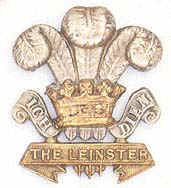The Prince of Wales's Leinster Regiment (Royal Canadians) Association
|
|

Regimental History
|
The Prince of Wales's Leinster Regiment (Royal Canadians) Association
Regimental History |
Quick OverviewThe Regiment came into being through the amalgamation
of 100th and 109th foot regiments. You may alternatively view a short history of the Regiment through to disbandment as a PDF 100th RegimentThere have been a number of instances of regiments numbered "100" in the
British Army's infantry of the line. The second 100th Regiment of Foot, later 92nd Regiment of Foot and later the Gordon Highlanders, was raised in 1794. The Government accepted an offer made by the Marquis of Huntly, eldest son of the 4th Duke of Gordon to raise a Highland regiment on the Gordon estates. The Gordon Highlanders embarked for England at Fort George on 9th July 1794, and joined the camp on Netley Common, Hampshire where the corps was, the following month, put on the establishment as the 100th Regiment. About 1799 the regimental number was changed to "92nd," the former regiment of that number having been reduced. The next regiment to be granted the title 100th Regiment of Foot was established in the British Army in March 1805. In 1812 the 100th Foot was granted the title H.R.H. the Prince Regent's County of Dublin Regiment of Foot. This regiment was disbanded in 1818 The next regiment to be raised as the 100th Regiment of Foot (Prince of Wales Royal Canadians) was a British infantry regiment raised in 1857 by officers of the Canadian Volunteers to serve in India in dealing with the Indian Mutiny. The regiment was embodied on the British Army establishment and numbered 100 in the infantry of the line. The full title was the 100th Regiment of Foot (Prince of Wales's Royal Canadians). The regiment was recruited in Canada in early 1858 and shipped to Shornecliffe Camp in England later that year. The battalion remained in England until 1863 when it proceeded on a tour of duty in Gibraltar and Malta until 1869, when it returned t o England. In 1877 it proceeded to Bengal. In the 1881 Cardwell reforms of the British Army, the 100th was retitled 1st Battalion the Prince of Wales's Leinster Regiment (Royal Canadians). The Regiment remained in India until 1895 when it returned home to Ireland. In 1898 the 1st Bn was despatched to Halifax, Nova Scotia and from there to South Africa in 1900. 109th RegimentFirst raised in 1761 for a three year period, when after serving in Belle Isle (Americas) it was disbanded in 1763. The number 109 was again used in 1794, this time for the Aberdeenshire Regiment but again the existence was brief with disbandment in 1795. The number lay dormant until 1862 when it was assigned to the 3rd Bombay European Regiment who had been formed in 1853 from soldiers of 1st Bombay Fusiliers, the 2nd Bombay Light Infantry and recruits from the Honourable East India Company's depot at Warley in Essex. With the amalgamation of British and East India Company forces, the 3rd Europeans and the Jaeger Corps were incorporated into the British Army as the 109th Foot. (Five Hundred men of the Jaeger Corps had volunteered from the Cape Colony for service in India on the outbreak of the Indian Mutiny had amalgamated with the 3rd Bombay European Regiment in 1860).Thus the 109th (Bombay Infantry) Regiment was formed. The regiment returned to England from India in 1877. On 1 July 1881, as part of the Cardwell reforms of the British Army, the 109th became the 2nd Battalion, The Prince of Wales's Leinster Regiment (Royal Canadians). In 1882 the 2 Bn moved to Ireland, back to England in 1888, to Malta in 1894, Bermuda in 1895, Halifax Nova Scotia in 1897, Jamaica 1898, Barbados 1898 and to South Africa in 1901. Sources: History of the British Regular Army 1660-1990 Volume one; A dative record of the Sovereigns' Regiments. Henry William and Catherine Patricia Adams (1990) Short Histories of the Territorial Regiments of the British Army, Volume II. Edited by R de M Rudolf, I.S.O.; Naval and Military Press Reprint |
Send mail with questions or comments about this web site using
this form
|